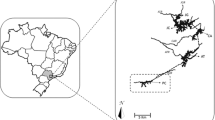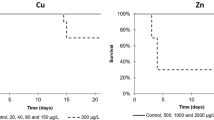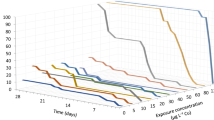Abstract
The development and hatchability ofChironomus decorus eggs were not affected by 0.1 to 5 mg/L of copper in water. The embryos developed normally and hatched at about the same time (after 55 hr of incubation). All larvae survived the duration of the test (72 hr) except those subjected to 5 mg/L of copper in water, which died after only partial emergence from the egg shell. Apparently, eggs were protected by their shell from copper. Growth ofC. decorus larvae was reduced significantly when they were reared in copper-spiked food-substrate (bound copper) from the age 1 to 15 days old (900–4,500 mg/kg of copper). The substrate copper concentration at which larval growth was reduced to 50% (EC50) was 1,602 mg/kg. Substrate copper caused deformities in the epipharyngeal plate of larval mouthparts and copper concentration higher than 1,800 mg/kg delayed adult emergence. The copper concentration in pupal exuviae and adults were positively correlated to copper concentration in the substrate in which they had been reared as larvae. Larval stage appeared to be the most sensitive to copper toxicity, while eggs were the least sensitive. Larval growth was the best indicator in detecting copper pollution, since it could detect copper at relatively low concentrations. The time to adult emergence was not considered a very good indicator, while larval deformities offered a quick tool to evaluate copper pollution.
Similar content being viewed by others
References
Aagaard K, Sivertsen B (1980) The benthos of Lake Huddingsvatn, Norway, after five years of mining activity. In: Murray DA (ed) Chironomidae: Ecology, systematics cytology and physiology. Proceedings of the Seventh International Symposium on Chironomidae, Dublin, August 1979, Pergamon Press, Oxford, pp 247–254
Biesinger KE, Christensen GM (1972) Effects of various metals on survival, growth, reproduction, and metabolism ofDaphnia magna. J Fish Res Board Can 29:1691–1700
Brown CC (1978) The statistical analysis of dose-effect relationships. In: Butler GC (ed) Principles of ecotoxicology. John Wiley and Sons, New York, pp 115–148
Buikema Jr AL, Benfield EF (1979) Use of macroinvertebrate life history information in toxicity tests. J Fish Res Board Can 36:321–328
Chapman G (1978) Toxicological considerations of heavy metals in the aquatic environment. In: Toxic materials in the aquatic environment. Seminar conducted by Water Resources Research Institute, Oregon State University, Corvallis, pp 69–77
— (1979) The insects: Structure and function. Elsevier North Holland, New York
Cleland KW (1953) Heavy metals, fertilization and cleavage in the eggs ofPsammechinus miliaris. Exp Cell Res 4:246–248
Cochran WG, Cox GM (1957) Experimental designs. 2nd edition. John Wiley and Sons, New York
Cushman RM (1984) Chironomid deformities as indicators of pollution from a synthetic, coal-derived oil. Freshwater Biol 14:179–182
D'Agostino A, Finney C (1974) The effects of copper and cadmium on the development ofTigriopus japonicus. In: Vernberg FJ, Vernberg WB (eds) Pollution and physiology of marine organisms. Academic Press, New York, p 445–463
Dejoux C (1971) Recherches sur le cycle de développement deChironomus pulcher (Diptera: Chironomidae). Can Entomol 103:465–470
Grande M (1967) Effect of copper and zinc on salmonid fishes. Proc 3rd Int Conf Water Pollution Research, Munich, 1966, 1:96–111
Hamilton AL, Saether OA (1971) The occurrence of characteristic deformities in the chironomid larvae of several Canadian lakes. Can Entomol 103:363–368
Hare L, Carter JCH (1976) The distribution ofChrionomus (s.s.)?cucini (salinarius group) larvae (Diptera: Chironomidae) in Parry Sound, Georgian Bay, with particular reference to structural deformities. Can J Zool 54:2129–2134
Heslinga GA (1976) Effects of copper on the coral-reef echinoid,Echinometra mathaei. Mar Biol 35:155–160
Hodson PV, Borgmann U, Shear H (1979) Toxicity of copper to aquatic biota. In: Nriagu JO (ed) Copper in the environment, part II: Health effects. John Wiley and Sons, New York, pp 307-372
Hueck HJ, Adema DM (1968) Toxicological investigations bearing on pollution problems in the North Sea. TNO Nieuws 23:58–64
Koehn T, Frank C (1980) Effect of thermal pollution on the chironomid fauna in an urban channel. In: Murray DA (ed) Chironomidae: Ecology, systematics cytology and physiology. Proceedings of the Seventh International Symposium on Chironomidae, Dublin, August 1979, Pergamon Press, Oxford, pp 187–194
Kosalwat P (1985) Culture ofChironomus decorus (Diptera: Chironomidae) and the effects of temperature and copper on their life history. PhD Dissertation. University of California, Davis, California
Langford TE, Daffern JR (1975) The emergence of insects from a British river warmed by power station cooling-water. Hydrobiologia 46:71–114
Macek K, Buxton K, Derr S, Dean J, Saunter S (1976) Chronic toxicity of lindane to selected aquatic invertebrates and fishes. Ecological Research Series EPA-600/3-76-046, Corvallis, Oregon
MacKenthum KM, Cooley HL (1952) The biological effect of CuSO4 treatment on lake ecology. Trans Wis Acad Sci Arts Lett 11:177–187
McKee JE, Wolf HW (eds) (1963) Water quality criteria. Publication 3-A, California State Water Resources Control Board, Sacramento
Nordlie KJ, Arthur JW (1981) Effect of water temperature on insect emergence in outdoor experimental channels. Environ Pollut Ser A 25:53–65
Nriagu JO (ed) (1979) Copper in the environment, part II: Health effects. John Wiley and Sons, New York
Spear PA, Pierce RC (1979) Copper in the aquatic environment: Chemistry, distribution and toxicology. National Research Council of Canada, NRCC No. 16454, Ottawa, Canada
Sprague JB (1976) Current status of sublethal tests of pollutants on aquatic organisms. J Fish Res Board Can 33:1988–1992
Thornton I (1979) Copper in soils and sediments. In: Nriagu JO (ed) Copper in the environment, part I: Ecological cycling. John Wiley and Sons, New York, pp 171–216
U.S. Environmental Protection Agency. Committee on Methods for Toxicity Tests with Aquatic Organisms (1975) Methods for acute toxicity tests with fish, macroinvertebrates, and amphibians. Ecological Research Series, EPA-660-3-75-009, Corvallis, Oregon
Warwick WF (1980) Pasqua Lake, southeastern Saskatchewan, a preliminary assessment of trophic status and contamination based on the Chironomidae (Diptera). In: Murray, DA (ed) Chironomidae: Ecology, systematics cytology and physiology. Proceedings of the Seventh International Symposium on Chironomidae, Dublin, August 1979, Pergamon Press, Oxford, pp 255–267
Wentsel R, McIntosh A, Atchison G (1977) Sublethal effects of heavy metal contaminated sediment on midge larvae (Chironmus tentans). Hydrobiologia 56:153–156
Wentsel R, Mclntosh A, McCafferty WP (1978) Emergence of the midgeChironomus tentans when exposed to heavy metal contaminated sediment. Hydrobiologia 57:195–196
Winkler LR, Chi LW (1964) Defensive mechanisms of the schistosome snail hostOncomelania formosana against copper sulphate in adult and egg stages. Am J Trop Med Hyg 13: 897–902
Author information
Authors and Affiliations
Rights and permissions
About this article
Cite this article
Kosalwat, P., Knight, A.W. Chronic toxicity of copper to a partial life cycle of the midge,Chironomus decorus . Arch. Environ. Contam. Toxicol. 16, 283–290 (1987). https://doi.org/10.1007/BF01054945
Received:
Revised:
Issue Date:
DOI: https://doi.org/10.1007/BF01054945




